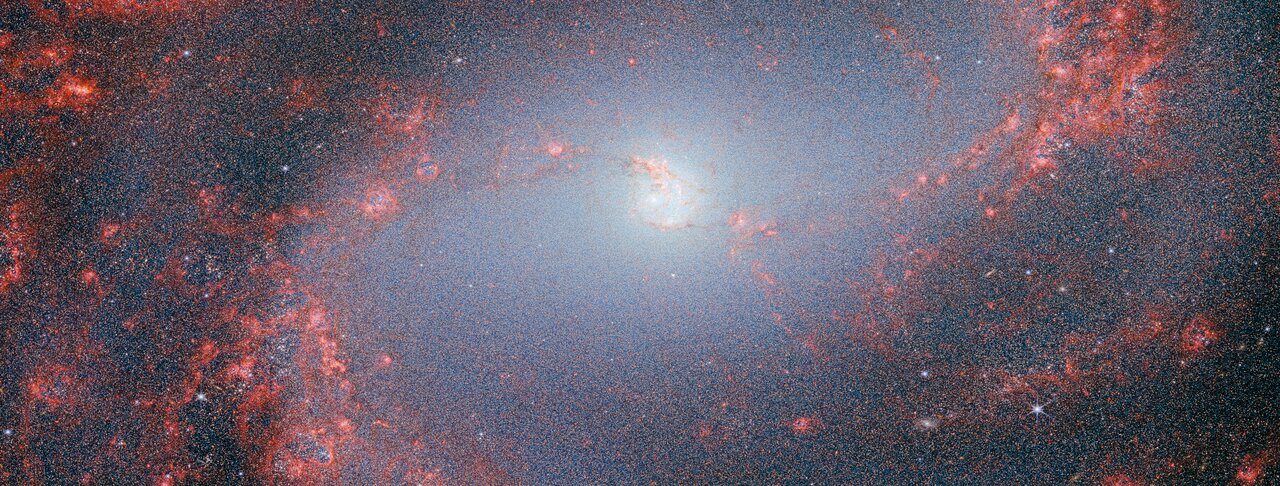About the Object
| Name: | M83 | |
|---|---|---|
| Distance: |
15 million light years | |
| Constellation: | Hydra | |
| Category: | Galaxies NIRCam Picture of the Month | |
Coordinates
| Position (RA): | 13 37 1.78 |
|---|---|
| Position (Dec): | -29° 52' 0.64" |
| Field of view: | 5.87 x 2.23 arcminutes |
| Orientation: | North is 49.6° left of vertical |
Colours & filters
| Band | Wavelength | Telescope |
|---|---|---|
| Infrared | 1.15 μm | James Webb Space Telescope NIRCam |
| Infrared | 1.5 μm | James Webb Space Telescope NIRCam |
|
Infrared
P-alpha | 1.87 μm | James Webb Space Telescope NIRCam |
| Infrared | 2.0 μm | James Webb Space Telescope NIRCam |
| Infrared | 3.0 μm | James Webb Space Telescope NIRCam |
|
Infrared
PAH | 3.35 μm | James Webb Space Telescope NIRCam |
|
Infrared
Br-alpha | 4.05 μm | James Webb Space Telescope NIRCam |
| Infrared | 4.44 μm | James Webb Space Telescope NIRCam |
No tricks, just treats (M83 NIRCam image)
This image, which truly is a visual treat, was captured by Webb’s NIRCam, or Near-InfraRed Camera. NIRCam makes observations in the near-infrared, which spans wavelengths of light that are just longer than optical wavelengths. Like MIRI, it is equipped with a range of filters that cover its wavelength range of 0.6 to 5 micrometres, including 29 filters specifically intended for imaging. Data collected through eight of those filters were used to complete this impressive image, which picks out light emitted from the wealth of stars that might be obscured by dust at other wavelengths. Even though stars do not emit the majority of their light in the infrared, optical light is much more vulnerable to being scattered by dust than infrared light is, and so infrared instruments like Webb can provide the best opportunities to study stars in regions (like galaxies) that might also contain large amounts of dust.
In this image, the bright red-pink spots correspond to regions rich in ionised hydrogen, which is due to the presence of newly formed stars. The diffuse gradient of blue light around the central region shows the distribution of older stars. The compact light blue regions within the red, ionised gas, mostly concentrated in the spiral arms, show the distribution of young star clusters.
[Image Description: A close-up view of a spiral galaxy. The core glows very brightly from the multitude of stars there, which are so dense they appear like noise or static. Near the edges of the image, the density of the stars notably follows the galaxy’s spiral arms. The two arms are highlighted by patchy red gas, connecting in the galactic centre. The gas is very thread-like in the centre and thicker further out along the arms.]
Links
- M83 (MIRI image)
- Slider tool (MIRI and NIRCam images)
- Video: Pan of M83 (MIRI image)
- Video: Pan of M83 (NIRCam image)
- Video: M83 (MIRI and NIRCam images)
ESA/Webb, NASA & CSA, A. Adamo (Stockholm University) and the FEAST JWST team
About the Image
| Id: | potm2310b | |
|---|---|---|
| Type: | Observation | |
| Release date: | 31 October 2023, 10:00 | |
| Size: | 8801 x 3342 px | |




